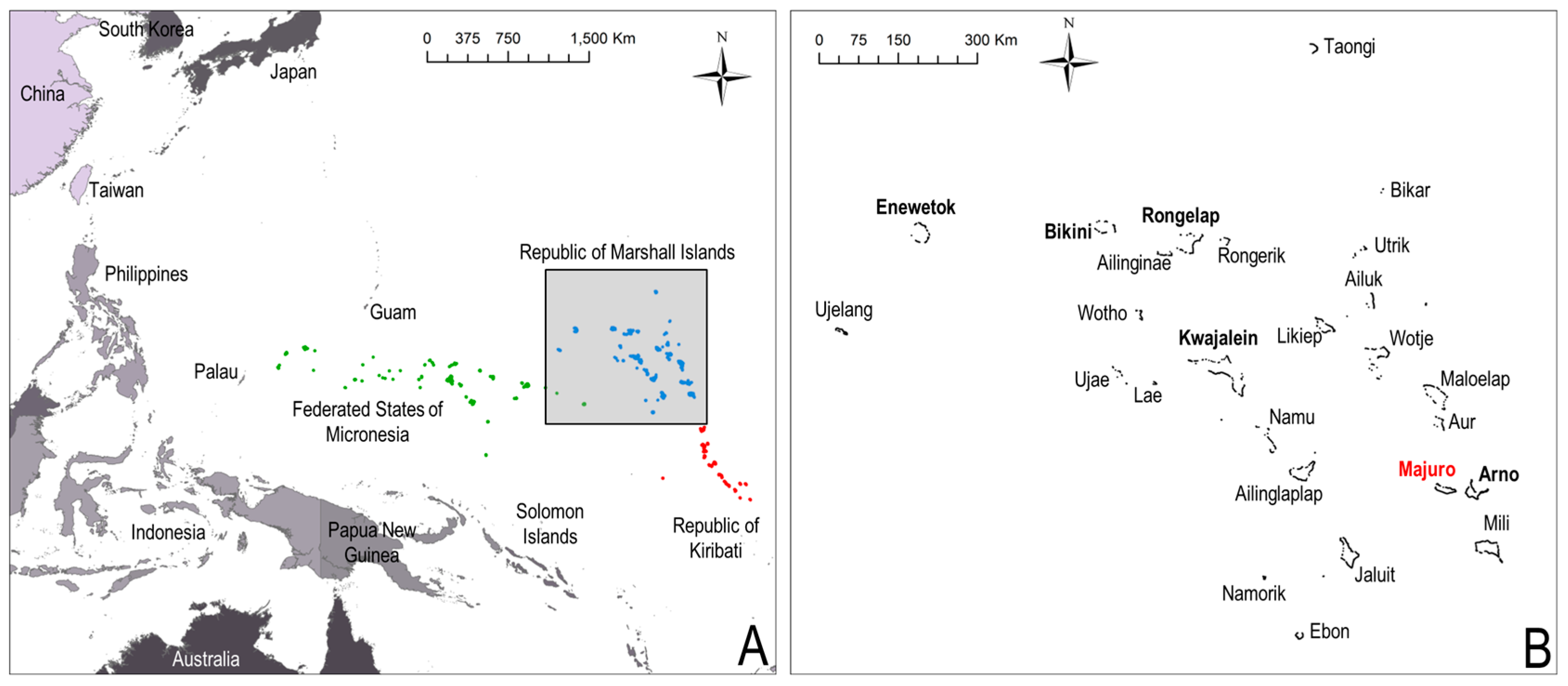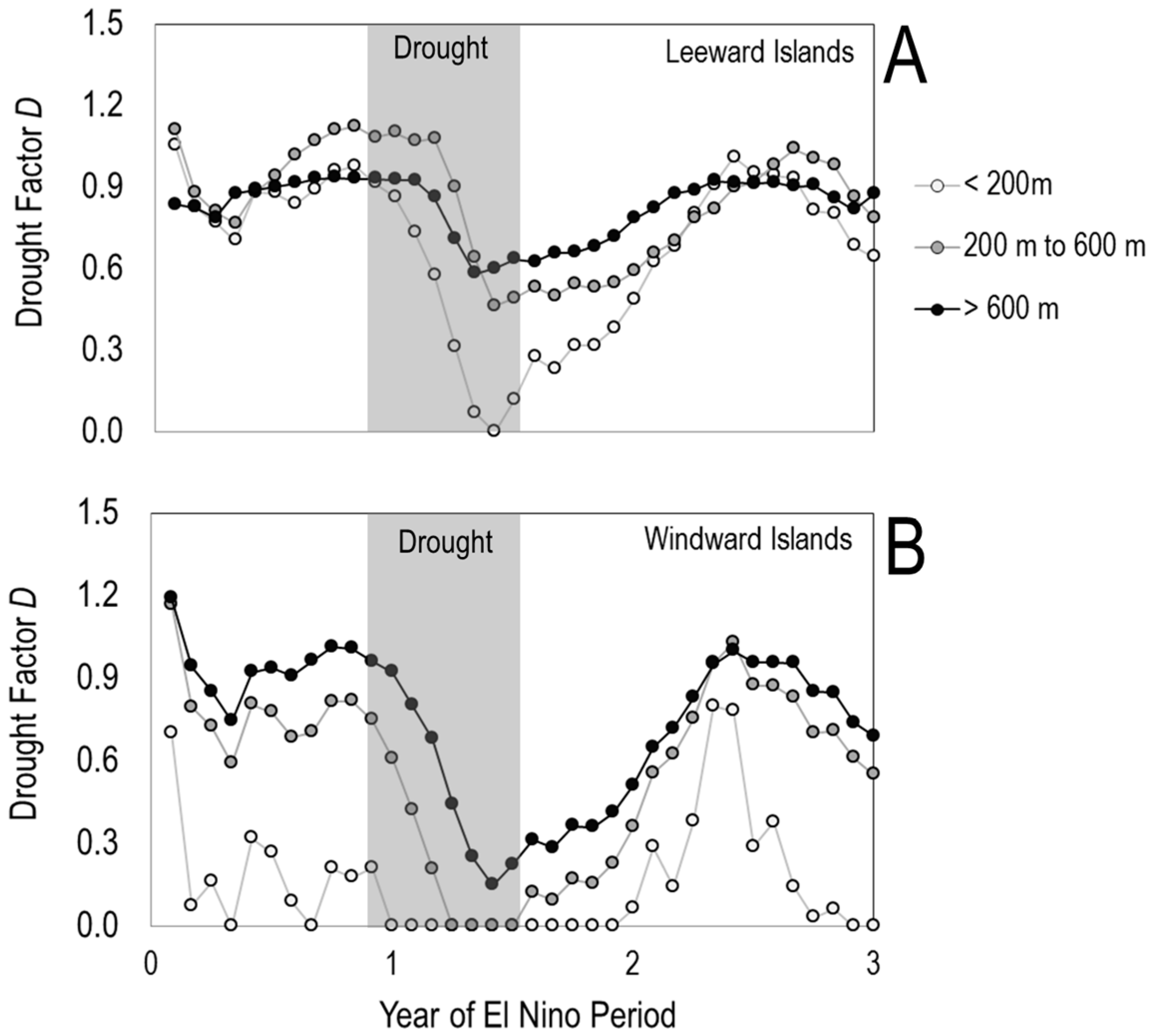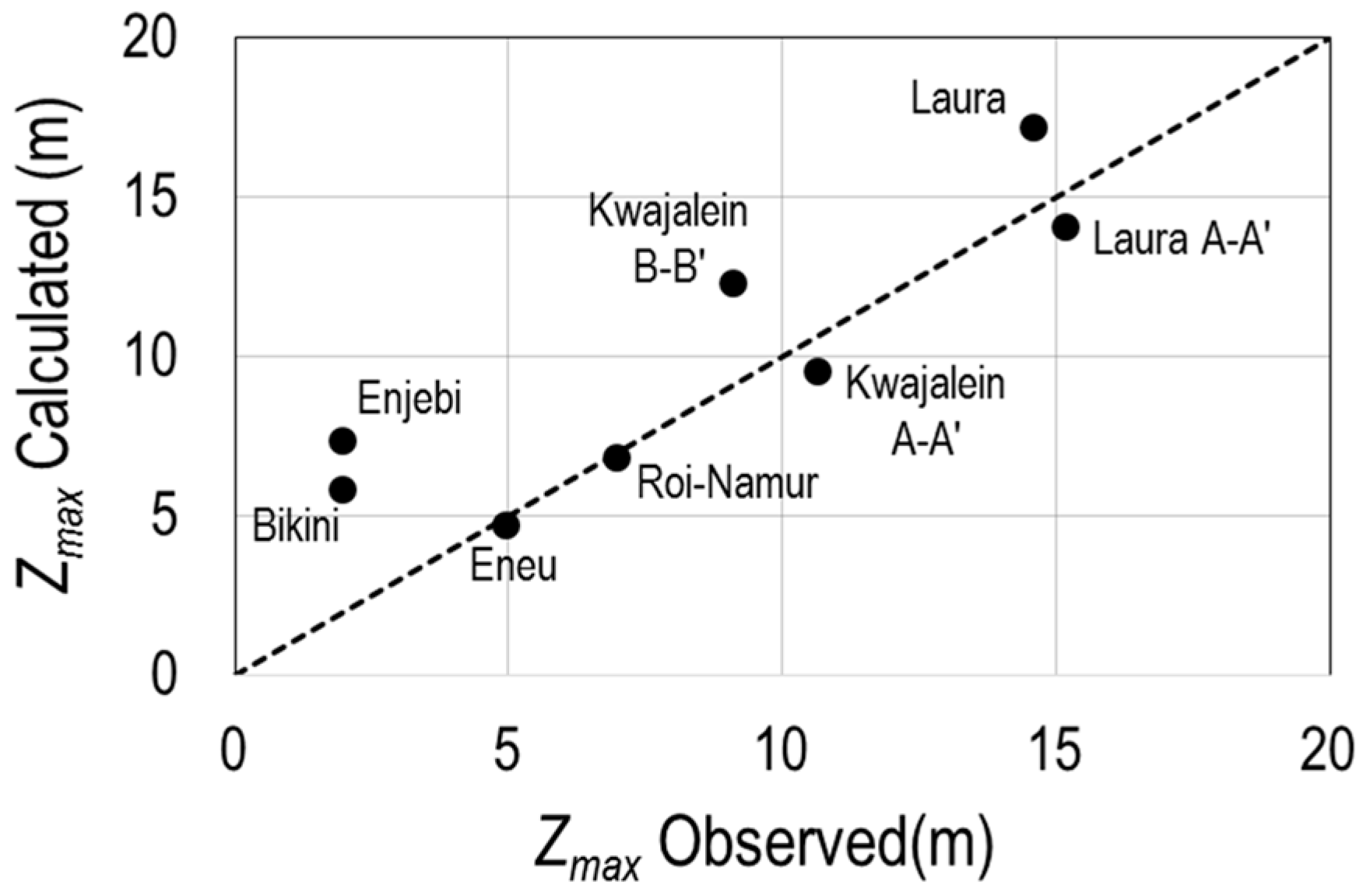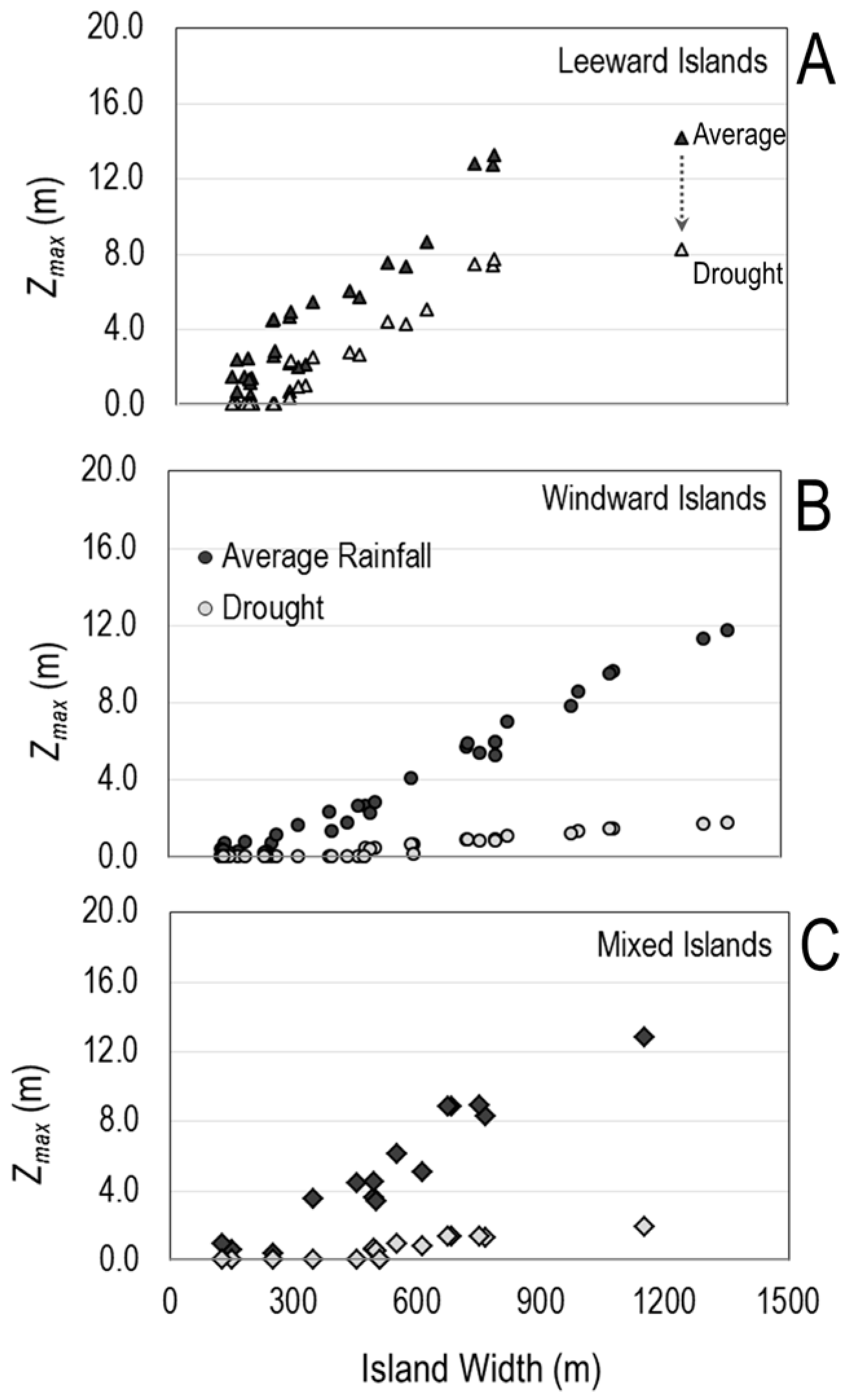Estimating the Impact of Drought on Groundwater Resources of the Marshall Islands
Abstract
:1. Introduction
2. Description of the Study Area: Republic of Marshall Islands
2.1. Geography
2.2. Climate and Water Resources
3. Assessing Groundwater Availability
3.1. Algebraic Model for Coral Island Freshwater Lens Thickness
3.2. Marshall Islands Groundwater Availability under Average Rainfall Conditions
3.3. Marshall Islands Groundwater Availability under Extreme Drought Conditions
4. Results and Discussion
4.1. Average Rainfall Conditions
4.2. Extreme Drought Conditions
5. Summary and Concluding Remarks
Supplementary Materials
Acknowledgments
Author Contributions
Conflicts of Interest
References
- Pernetta, J.C. Impacts of climate change and sea-level rise on small island states. National and international responses. Glob. Environ. Chang. 1992, 2, 19–31. [Google Scholar] [CrossRef]
- Roy, P.; Connell, J. Climate change and the future of atoll states. J. Coast. Res. 1991, 7, 1057–1075. [Google Scholar]
- White, I.; Falkland, T.; Perez, P.; Dray, A.; Metutera, T.; Metai, E.; Overmars, M. Challenges in freshwater management in low coral atolls. J. Clean. Prod. 2007, 15, 1522–1528. [Google Scholar] [CrossRef]
- Woodroffe, C.D. Reef-island topography and the vulnerability of atolls to sea-level rise. Glob. Planet. Chang. 2008, 62, 77–96. [Google Scholar] [CrossRef]
- White, I.; Falkland, T.; Scott, D. Droughts in Small Coral Islands: Case Study, South Tarawa, Kiribati; Technical Documents in Hydrology No. 26; UNESCO International Hydrologic Programme: Paris, France, 1999. [Google Scholar]
- Burns, W.C.G. The impact of climate change on Pacific island developing countries in the 21st century. In Climate Change in the South Pacific: Impacts and Responses in Australia, New Zealand, and Small Island States; Gillespie, A., Burns, W.C.G., Eds.; Springer: Berlin/Heidelberg, Germany, 2000; pp. 233–250. [Google Scholar]
- White, I.; Falkland, T. Management of freshwater lenses on small Pacific islands. Hydrogeol. J. 2010, 18, 227–246. [Google Scholar] [CrossRef]
- Taboroši, D.; Martin, M. Pakein Atoll: Freshwater Resourcesand Their Usage, State, and Infrastructure; Island Research & Eduation Initiative: Palikir, Federated States of Micronesia, 2011. [Google Scholar]
- Pacific RISA. Available online: http://www.pacificrisa.org/places/republic-of-the-marshall-islands/ (accessed on 22 September 2015).
- Cox, D.C. The Hydrology of Arno Atoll, Marshall Islands; Atoll Research Bulletin 8; The Pacific Science Board: Washington, DC, USA, 1951; pp. 1–29. [Google Scholar]
- Arnow, T. The Hydrology of the Northern Marshall Islands; Atoll Research Bulletin 8; The Pacific Science Board: Washington, DC, USA, 1954; pp. 1–29. [Google Scholar]
- Hunt, C.D., Jr.; Peterson, F.L. Groundwater Resources of Kwajalein Island, Marshall Islands; Technical Report No. 126; Water Resources Research Center, University of Hawaii: Honolulu, HI, USA, 1980. [Google Scholar]
- Buddemeier, R.W.; Holladay, G. Atoll hydrology: Island characteristics and their relationship to diagenesis. In Proceedings of Third International Coral Reef Symposium Vol. 2: Geology; Rosenstiel School of Marine and Atmospheric Science: Miami, FL, USA, 1977. [Google Scholar]
- Wheatcraft, S.W.; Buddemeier, R.W. Atoll island hydrology. Ground Water 1981, 19, 311–320. [Google Scholar] [CrossRef]
- Herman, M.E.; Wheatcraft, S.W. Groundwater Dynamics Investigation of Enjebi Island, Enewetak Atoll: An Interpretive Computer Model Simulation, Finite Elements in Water Resources; Springer: New York, NY, USA, 1984; pp. 133–142. [Google Scholar]
- Hamlin, S.N.; Anthony, S.S. Ground-Water Resources of the Laura Area, Majuro Atoll, Marshall Islands; USGS Water Resources Investigation Report 87-4047; U.S. Geological Survey: Reston, VA, USA, 1987.
- Presley, T.K. Effects of the 1998 Drought on the Freshwater Lens in the Laura Area, Majuro Atoll, Republic of the Marshall Islands; USGS Scientific Investigations Report 2005-5098; U.S. Geological Survey: Reston, VA, USA, 2005.
- Gingerich, S.B. Numerical Simulation of the Freshwater Lens on Roi-Namur Island, Kwajalein Atoll. Master’s Thesis, University Hawaii, Honolulu, HI, USA, 1992; p. 110. [Google Scholar]
- Bailey, R.T.; Jenson, J.W.; Taborosi, D. Estimating the freshwater lens thickness of atoll islands in the Federated States of Micronesia. Hydrogeol. J. 2013, 21, 441–457. [Google Scholar] [CrossRef]
- Bailey, R.T.; Khalil, A.; Chatikavanij, V. Estimating Current and Future Groundwater Resources of the Maldives. J. Am. Water Resour. Assoc. 2014, 51, 112–122. [Google Scholar] [CrossRef]
- Peterson, F.L. Hydrogeology of the Marshall Islands. In Geology and Hydrogeology of Carbonate Islands. Development in Sedimentology; Elsevier Science: Amsterdam, The Netherlands, 1997; pp. 611–666. [Google Scholar]
- Anthony, S.S. Hydrogeology of selected islands of the Federated States of Micronesia. In Geology and Hydrogeology of Carbonate Islands, Developments in Sedimentology 54; Vacher, H.L., Quinn, T., Eds.; Elsevier Science: Amsterdam, The Netherlands, 1997; pp. 693–706. [Google Scholar]
- Buddemeier, R.W.; Oberdorfer, J.A. Hydrogeology of Enewetak Atoll. In Geology and Hydrogeology of Carbonate Islands, Developments in Sedimentology 54; Vacher, H.L., Quinn, T., Eds.; Elsevier Science: Amsterdam, The Netherlands, 1997; pp. 667–692. [Google Scholar]
- Ayers, J.F.; Vacher, H.L. Hydrogeology of an atoll island: A conceptual model from detailed study of a Micronesian example. Ground Water 1986, 24, 185–198. [Google Scholar] [CrossRef]
- Spennemann, D.H.R. Non-traditional settlement patterns and typhoon hazard on contemporary Majuro Atoll, Republic of the Marshall Islands. Environ. Manag. 1996, 20, 337–348. [Google Scholar] [CrossRef]
- Bailey, R.T.; Jenson, J.W.; Olsen, A.E. Numerical Modeling of Atoll Island Hydrogeology. Ground Water 2009, 47, 184–196. [Google Scholar] [CrossRef] [PubMed]
- Bailey, R.T.; Jenson, J.W.; Olsen, A.E. Estimating the ground water resources of atoll islands. Water 2010, 2, 1–27. [Google Scholar] [CrossRef]
- Voss, C.I.; Provost, A.M. SUTRA, A Model for Saturated-Unsaturated Variable-Density Ground-Water Flow with Solute or Energy Transport; USGS Water-Resources Investigations Report 02-4231; U.S. Geological Survey: Reston, VA, USA, 2003; pp. 1–250.
- Google Maps. Available online: https://www.google.com/maps/place/Marshall+Islands/@11.3249945,166.7016573,67453m/ (accessed on 1 October 2015).
- White, I.; Falkland, T.; Metutera, T.; Metai, E.; Overmars, M.; Perez, P.; Dray, A. Climatic and human influences on groundwater in low atolls. Vadose Zone J. 2007, 6, 581–590. [Google Scholar] [CrossRef]










| Island | Atoll | Location | Width (m) | Observed (m) | Model (m) | Reference |
|---|---|---|---|---|---|---|
| Bikini | Bikini | NW | 700 | 2 | 5.8 | [21] |
| Eneu | Bikini | NW | 500 | 5 | 4.7 | [21] |
| Enjebi | Enewetak | NW | 986 | 2 | 7.3 | [13] |
| Kwajalein A-A’ | Kwajalein | Central | 600 | 10.7 | 8.1 | [12] |
| Kwajalein B-B’ | Kwajalein | Central | 730 | 9.1 | 10.5 | [12] |
| Roi-Namur | Kwajalein | Central | 800 | 7 | 6.7 | [18] |
| Laura | Majuro | SE | 1240 | 14.6 | 17.1 | [16] |
| Laura A-A’ | Majuro | SE | 450 | 15.2 | 14.0 | [17] |
| Date | Cross Sections | |||
|---|---|---|---|---|
| A-A’ | B-B’ | D-D’ | E-E’ | |
| 450 m | 750 m | 1200 m | 750 m | |
| 1 January 1998 | 15.2 | - | - | - |
| 8 June 1998 | 7.9 | 11.3 | 14.6 | 11.3 |
| 28 August 1998 | 8.2 | 11.9 | 15.8 | 13.7 |
| 14 January 1999 | 9.8 | 12.5 | 17.1 | 13.7 |
© 2017 by the authors; licensee MDPI, Basel, Switzerland. This article is an open access article distributed under the terms and conditions of the Creative Commons Attribution (CC-BY) license (http://creativecommons.org/licenses/by/4.0/).
Share and Cite
Barkey, B.L.; Bailey, R.T. Estimating the Impact of Drought on Groundwater Resources of the Marshall Islands. Water 2017, 9, 41. https://doi.org/10.3390/w9010041
Barkey BL, Bailey RT. Estimating the Impact of Drought on Groundwater Resources of the Marshall Islands. Water. 2017; 9(1):41. https://doi.org/10.3390/w9010041
Chicago/Turabian StyleBarkey, Brandon L., and Ryan T. Bailey. 2017. "Estimating the Impact of Drought on Groundwater Resources of the Marshall Islands" Water 9, no. 1: 41. https://doi.org/10.3390/w9010041
APA StyleBarkey, B. L., & Bailey, R. T. (2017). Estimating the Impact of Drought on Groundwater Resources of the Marshall Islands. Water, 9(1), 41. https://doi.org/10.3390/w9010041






